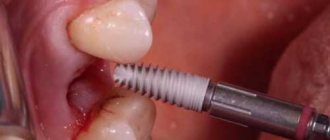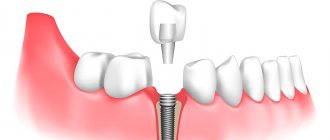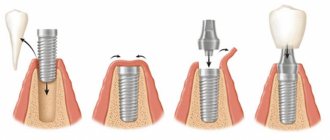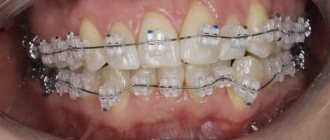After tooth extraction, the state of the dental system changes, the chewing load is redistributed, the bone tissue in the resulting gap is stabilized, and the hole is overgrown. All changes occur gradually, but over time the consequences manifest themselves in the form of bone atrophy, changes in the bite and subsidence of the gums. Is it possible to place an implant immediately after removal? Only an experienced specialist will answer the question, since it directly depends on the patient’s health condition. What implantation methods do modern dentistry offer and when can a dental implant be installed? Let's take a closer look.
When can a dental implant be placed after tooth extraction?
There are several methods for installing dental implants: two-stage, one-stage, one-stage. The latter is used immediately after tooth extraction. Its main difference is that the patient should have no contraindications for the operation, and the implantologist is fully prepared for the intended procedure. In practice, simultaneous implantation is rarely carried out, since most often they end up in the dentist’s chair too late, when the disease has progressed to an acute or chronic stage, severe pain has appeared and emergency removal is required. During a planned removal, the implantologist has from 2 to 14 days to prepare: collecting tests to identify contraindications, making casts of the jaw and a surgical template, selecting medications and creating a crown for the implant.
Features of the rehabilitation period
After the operation, the implantologist will give detailed recommendations to the patient regarding care, regimen, and nutrition. Since the implantation was gentle, pain is usually mild or absent. Discomfortable sensations, as after a regular removal, go away on their own within 3-5 days.
Scrupulous adherence to medical instructions in the postoperative period ensures rapid and trouble-free healing and prevents the development of complications. Recommendations are conventionally divided into general and medical.
Pros and cons of implantation immediately after tooth extraction
Unlike classic removable prosthetics, a dental implant has many advantages: 1. Natural pressure is applied to the bone tissue, comparable to the load on your own tooth root. For this reason, atrophy does not progress, the process slows down, and when choosing high-quality implants, changes do not affect the gums for more than 5 years; 2. Reliable fixation of the prosthesis in the mouth allows you to eat your usual food and perform oral hygiene using conventional means; the prosthesis does not interfere with diction, feels like one’s own tooth, without changing the patient’s usual lifestyle; 3. You can chew with dental implants installed immediately after tooth extraction, after their complete healing, just like with your own teeth. In terms of reliability, they are not inferior to conventional implants installed using other methods; 4. When installing an implant on the day of removal, bone tissue augmentation is not required or is minimal (bone material is added to the tooth socket during the operation). This approach significantly saves time for more complex bone augmentation operations (can take from 3 to 6 months); 5. The patient needs to visit the dentist less, both for diagnosis and for surgery and subsequent monitoring. Time is saved for travel and doctor appointments without loss of quality; 6. Neighboring teeth are preserved, since implantation does not require additional supports or preparation of other teeth. In the long term, this will save teeth from falling out and destruction; 7. The service life of a dental implant is from 8 to 15 years if it belongs to the economy class segment, from 10 to 20 years in the middle segment, and premium class implants last more than 20 years. Removable dentures require adjustment and replacement on average every 5 years, while the reliability of the fit is less due to changes in bone tissue.
Stages of treatment
- Preparation
- collection of anamnesis, examination and examination of the patient for contraindications (laboratory tests), assessment of the condition of the oral cavity and dental apparatus (orthopantomogram, 3D tomography), hygienic cleaning (removal of plaque, tartar). - Implant installation
- the doctor carefully removes the affected tooth in order to minimally injure the alveolar process. Forms a bone bed if the hole is not suitable in size for installing an implant. Screws the titanium root into the prepared hole, fills it with bone chips (for better stabilization of the implant), and sutures the gum. - Temporary prosthetics
- according to the clinical picture, with a one-stage protocol, one-piece or two-piece (classical) implant models can be used. Three types of prostheses are used as an adaptive orthopedic design: removable immediate prosthesis; - lightweight plastic crown;
- complete denture with plastic artificial ones.
- prosthetics with a permanent orthopedic system is performed after complete fusion of the titanium root with the bone. If the implant is implanted using classical technology, it is left for 3-5 months, then loaded with a permanent prosthesis.
A single crown can only be installed on single-rooted units (incisors, canines) that are not subject to heavy loads. In this case, the crown is removed from the bite (made below the dental arch) to eliminate any pressure on the titanium root.
How is the procedure done?
At the first stage, the patient visits the clinic for diagnostics. The blood is submitted to a laboratory for analysis; the analysis takes from one to several days. If you have your own diagnostic unit, the results can be known in a few hours. Afterwards an X-ray examination is carried out. To assess the condition of the jaw, a panoramic X-ray or computed tomography of the jaw is taken and the result is recorded on an information medium. If the patient goes to a third-party clinic or specialized center, the computed tomography scan is issued on a disk with the seal of the medical institution, signature and transcript of the specialist. Printing on film is rarely done, since electronic recording is more informative for the doctor. At the first appointment, the patient and dentist, having all the necessary data, discuss the expected result and which implantation options are most suitable for a particular patient. If during the examination no contraindications are identified, a treatment plan is drawn up that meets the patient’s wishes, then the dentist proceeds to the preparation stage.
In order for dental implantation to be successful immediately after removal, the dentist uses a computer model to predict the outcome of the operation. On the appointed day, the patient’s tooth is removed under anesthesia. An implant is placed in the socket, powdered bone material is added if necessary, and sutures are placed to close the operated area and stabilize the implant.
It is impossible to put a full load on an artificial tooth immediately after implantation, since primary stability can be disrupted. It is recommended not to overheat, hypothermia or physically overexert in the first week after surgery. In the first two months, it is recommended to follow a diet. Eat foods rich in vitamins and minerals, not spicy, salty or sour, as such foods irritate the mucous membrane.
The engraftment process takes from 4 to 6 months. After this time, the dentist will schedule a visit to determine the condition of the implant. When healing is complete, the crown is replaced. If the immediate loading technique was used, then initially a plastic crown is installed on the implant. This material is lighter and more aesthetic, and does not load the implant. But after six months of wearing it, it must be changed to ceramics, metal ceramics or zirconium. If a delayed loading protocol is used, a permanent crown is placed. It is fixed to the implant using an abutment after engraftment. The orthopedic stage completes the implantation process, after which the patient can chew and eat familiar foods.
After all procedures are completed, the patient must visit the dentist twice a year. This is necessary to preserve the implant and maintain stable oral health. During preventive examinations, the patient is recommended to undergo a hygienic teeth cleaning procedure. The plaque that forms in the oral cavity cannot be cleaned with a regular brush, even if all hygiene rules are followed. Professional cleaning helps prevent the accumulation of hard plaque around the implant, removes the yellow bacterial film, makes teeth naturally white, and eliminates microbes that cause gum inflammation. Gum disease directly affects the condition of the implant; in weakened gums, it becomes loose and falls out. Ultrasound cleaning reduces the risk of developing any periodontal diseases and improves the condition of teeth and gums.
Indications and contraindications for immediate implant placement
Indications
- Mechanical damage to the root - fracture, dislocation
- Restoration of frontal units
- Therapeutic treatment did not bring results
- Sufficient bone volume
- No contraindications
Contraindications
- Deficiency, looseness of bone
- Inflammation at the root apex
- Enlarged socket after removal
- Inflammatory processes of the oral cavity, gum pathologies
- Reduced immunity, systemic diseases
- Pregnancy, breastfeeding period
Guarantees
We undertake guarantee obligations for the quality of services provided.
- If a classic implant fails within 12 months after surgery, the patient is guaranteed a replacement. The exception is clinical cases when diagnostics reveal contraindications to the procedure.
- If a one-stage implant fails within a year and before replacing the conditionally removable structure with a permanent prosthesis, the patient has the right to have the artificial root re-installed. An obstacle to the procedure is the presence of contraindications for health reasons in the patient.
The guarantee is valid if the patient complies with the requirements of the medical institution:
- Completion of annual professional oral hygiene.
- Compliance with the schedule of preventive examinations.
- Follow the implantologist’s recommendations on nutrition and dental care at home.
If the requirements are violated, no warranty is provided.
Price
The cost of one-stage “turnkey” implantation includes:
- diagnostics;
- price of the implantation system;
- operation to introduce an artificial root;
- installation of an adaptive prosthesis (including the prosthesis itself);
- routine examinations by the attending physician within 1 year.
Additional treatment increases the cost - before the procedure, complete sanitation of the oral cavity, professional oral hygiene, and bone grafting (if necessary) are performed. These services are paid separately at the preparatory stage.
The initial consultation with an implantologist and monthly preventive examinations for a year after surgery are free. The Roott Clinic provides step-by-step payment for medical services.
Free online consultation with a dentist
| Service | Price |
| Simultaneous installation of a ROOTT implant (Switzerland, Trate AG): together with tooth extraction and an adaptation crown | from 47,500 rub. |
Consultation and diagnostics are free!
All prices Promotions
Work examples
All works
Complex implantation (top and bottom)
Implantation of all teeth in the upper jaw
Simultaneous implantation of two jaws
Full dental implantation and prosthetics
Complete restoration of the upper jaw on implants
Complex restoration of both jaws on implants
Upper jaw - teeth under the crowns are destroyed, lower jaw - teeth abrasion
Periodontal disease III degree
Stage III periodontal disease: complex dental implantation
Implantation of one tooth with a single-stage load
Restoration of the upper jaw in 4 days using a single-phase method Full implantation
Restoration of the upper jaw using the ROOTT single-phase implantation system
Single-stage implantation for periodontal disease
Restoration of chewing and aesthetic function with one-stage implantation
Implantation with simultaneous removal of all teeth and installation of implants with crowns
Implantation of both jaws with ROOTT implants for stage II periodontal disease
Sinus lift with simultaneous implantation
All works
Sign up for a consultation
three ROOTT specialists + diagnostics as a gift
Preparation
The purpose of the preparatory stage is to assess the clinical picture and choose treatment tactics. The doctor evaluates the patient’s general health and oral cavity in order to create conditions for the safe introduction of the implant and its healing. Preparation includes the following steps:
- Taking a medical history to assess the patient's general condition and identify potential risks of complications.
- Examination of the oral cavity. If during the examination the patient is found to have carious lesions or bacterial plaque, they must be eliminated before surgery.
- Computed tomography (CT) and panoramic image of the jaw (orthopantomogram) to determine the volume and density of bone tissue and diagnose inflammatory processes.
Based on the diagnostic results, the doctor draws up a treatment plan and selects an implantation system that is suitable for a specific clinical case.
At the ROOTT Clinic, the operation has a predictable result in advance. Our specialists draw up an action plan in advance and strictly follow the protocol at all stages of treatment.











